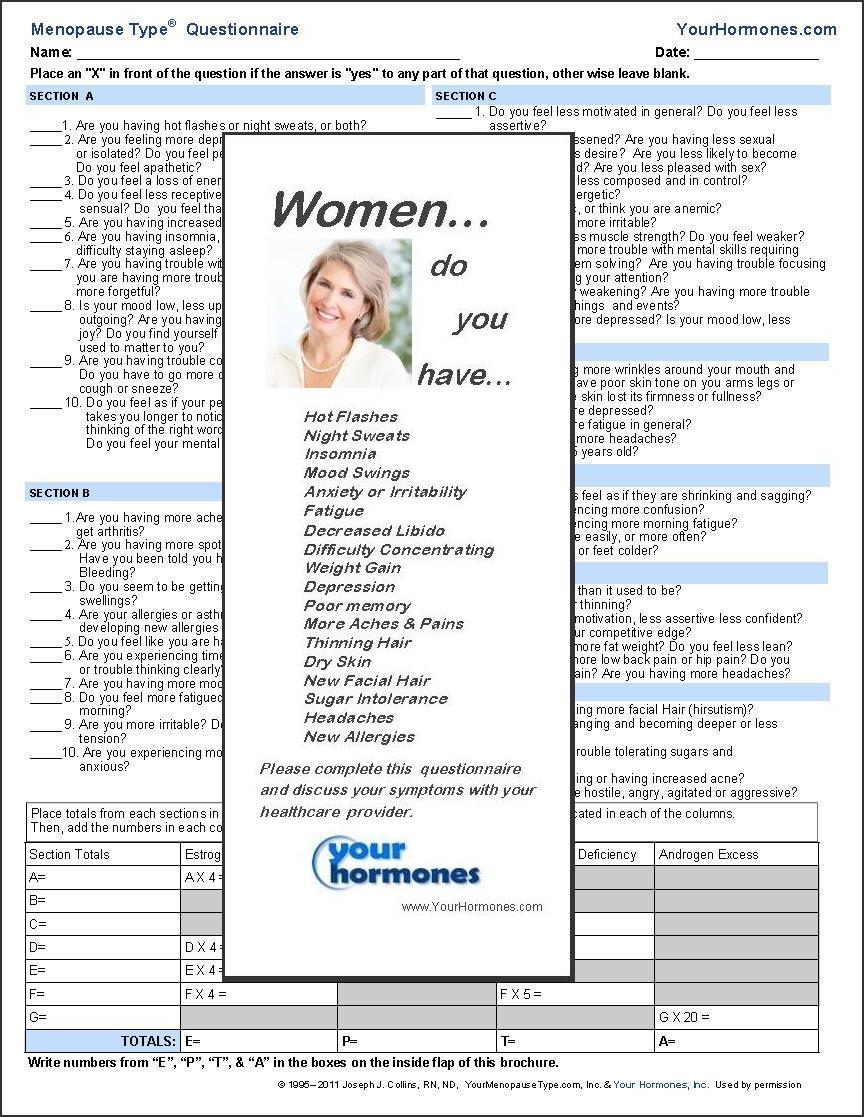Menopause Type® Questionnaire by Joseph J Collins, RN, ND
The Menopause Type® Questionnaire will show you what type of menopause you have based on mathematical analysis of your symptoms. This questionnaire is used worldwide by both patients and healthcare professionals. This questionnaire is in the book: Discover Your Menopause Type, which is the book that redefined menopause as having significant hormonal variations, and dispelled the “one-size-fits-all” approach of the last century. This questionnaire will help you determine if you would benefit from taking EstroMend™, ProgestoMend™, TestoGain™, or TestoQuench™ for Women at this time. It is best to save the questionnaire after you fill it out so that you can compare in with answers you choose when you repeat the questionnaire. This will allow you to see the improvements that take place with the Hormone Specific™ Formulations.
Menopause Type® Questionnaire Trifold Brochure
Menopause Type® Questionnaire Clinical Form
Download Adobe Reader to view this documents.
How to use the Hormone Health Questionnaires
In general terms, the hormone health questionnaires on YourHormones.com are advanced clinical tools that incorporate clinical data with bioinformatics analysis of symptom clusters and allow both healthcare professionals and patients to have quantifiable information on specific hormone imbalances. Simply put, they “give your numbers you can work with”. Just as we would look at the numbers on a lab test, we can now look at the numbers on highly specific symptom questionnaires. These questionnaires only examine symptoms and risks based on information you provide. They are not a replacement for a healthcare professional. These questionnaires are designed to mimic the way a healthcare practitioner would think. Healthcare practitioners will look at many symptoms and try to analyze the total symptoms so they can determine what their diagnosis should be, and what recommendations to make. These questionnaires help determine what symptoms are present, and help analyze the symptoms by providing numbers tha allow both healthcare professionals and patients to use these questionnaires for four distinct purposes.
First, the questionnaires can be used for initial evaluation. They can help analyze symptoms and risks, which can assist healthcare professionals in making a more specific diagnosis which reveals the subtle variations that exist with any hormonal imbalance. For example the Menopause Type® Questionnaire goes far beyond a simple diagnosis of “menopause” to a more precise diagnosis of which specific hormones are causing the symptoms. The Hypothyroid Risk Questionnaire™ can help determine the probability that a complex cluster of symptoms may be due to hypothyroid function, or if the risk is so low that other problems should be looked at (such as andropause, adrenal fatigue, menopause, PMS, etc.).
Correlating Objective & Subjective Data
Second, the questionnaires are used to get the “big picture” such as correlating objective & subjective data (signs & symptoms). Healthcare professionals often recognize two general categories of information. One is objective data can be observed, such as lab test, x-rays, rashes, night sweats, or specific behaviors or signs that can be studied. Subjective data is experienced by the person, such as physical symptoms and emotional feelings. Sometimes symptoms do not agree with objective data. For example, a person may have symptoms of low testosterone even though their testosterone (and free testosterone) is fine. So, the healthcare professional may correlate (compare) symptoms with lab tests and determine that the problem is not testosterone deficiency, but testosterone dysfunction. Healthcare professionals are trained to correlate signs and symptoms. The questionnaires help with that process. Correlative interpretation is used in lab tests analysis such as the Female Hormone Health Profile™ which analyzes both symptoms and lab tests.
Evaluate Response to Therapy
Third, the questionnaires are used to evaluate response to therapy. This is a great way to monitor improvements in hormone health. Use the appropriate questionnaire(s) before starting any therapy, then use the questionnaire(s) again after 3 to 4 weeks. By doing this you can determine how fast the response to therapy is, or if foundational therapies (detoxification, nutrients, sleep, etc.) need to be given more attention. Once a person stays feeling better for a few months, the questionnaire(s) can be used to monitor the weaning process and determine a good maintenance dose of therapies.
Monitor Long Term Health
Fourth, the questionnaires are used to monitor long term health. Even after hormone health has been restored, the questionnaire(s) can be used long term to make sure hormone imbalance symptoms do not come back, especially if there is an illness/injury or other major stress event. Since many hormone imbalances may occur as part of the aging process, the questionnaires can in effect be part of the yearly exam that a patient goes through. And as important, is the ability for a patient to compile their hormone specific symptoms into a concise list that demonstrates how their symptoms are improving – or if they are coming back years later.
Using Any Questionnaire
When using any questionnaire it is important to remember that the word “diagnoses” means “complete knowledge” (dia= complete, gnoses = knowledge). If we are to be honest we will all admit that we never really have “complete knowledge”, but we should also try to avoid incomplete knowledge. If there are serious concerns of a significant hormone imbalance, then laboratory testing should be part of the evaluation.

